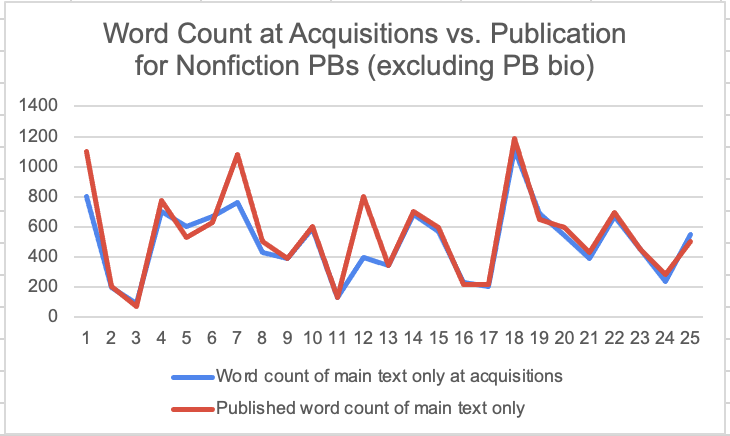One of the most frequently asked questions I get from newer nonfiction picture book writers is: “How many words should my book be?”
Nonfiction picture book writers often have heard their book must be 1,000 words or fewer, sometimes even 800 words or fewer. But is this really true? To get the straight scoop, I undertook a word count survey for debut nonfiction authors in early 2024 to see what word counts editors are actually acquiring and publishing.
Methodology
The authors in the survey had not previously been published in any category. The reasoning was that previously published authors, no matter the genre or category, may have more freedom and flexibility when it came to word count.
This was an opt-in survey that used a Google form to collect data (The form is still open so I can continue to collect data). Aside from publicizing the survey on social media, I reached out to debut authors I found by searching Publishers Marketplace deals from 2021 onward (when PM started breaking out nonfiction picture books from fiction picture books) and by contacting authors through debut picture book marketing groups.
The data set includes books acquired between 2017 and 2023 for publication between 2020 and 2027. I included not-yet published books in the survey, as long as editing and the basic layout were complete so the final word count and page count were known.
My survey was open from February 7, 2024-March 7, 2024, and received 40 responses, 14 of which were picture book biographies; 26 other nonfiction.
Publishers represented include: Calkins Creek, Minedition, Barefoot Books, Millbrook, Beaming Books, HarperCollins, Little, Brown Books for Young Readers, Chronicle, Web of Life Books, Knopf, Running Press Kids, Capstone, Albert Whitman, Peachtree, Scholastic, Sleeping Bear, Becker & Mayer Kids, Yeehoo Press, Worthy Kids, Page Street Kids, Holiday House, Viking, Simon & Schuster, Sky Pony Press, Kar-Ben Publishing, and Tilbury House.
The results
| PB bios | Other Nonfiction PBs | |
| Average word count at acquisitions | 1,116 words | 497 words |
| Word count range at acquisitions | 737 to 2,000 words | 93 to 1,113 words |
| Average word count at publication | 1,086 words | 547 words |
| Word count range at publication | 730 to 1,400 words | 74 to 1,185 words |
| Most common page count | 40 pages | 32 pages |
| Target age range (lower limit) | 5.36 years | 4.31 years |
| Target age range (upper limit) | 9.07 years | 8.23 years |
Analysis – Picture Book Biography Word Counts
So, do nonfiction picture books have to be under 1,000 words to be acquired? The answer is no, especially when it comes to picture book biographies. Picture book biographies (PB bios) tend to be longer than other nonfiction picture books, both at acquisitions and at publication. The range at publication was 730 to 1,400 words.
And here’s another really interesting tidbit: 50% percent of the time, a PB bio’s word count INCREASED during the editing process. The sweet spot seems to be in the range of 850 to 1,300 words, when you remove the shortest and longest books.

It might be helpful here to have a chart that shows both word counts at acquisitions and publication for each PB bio in the study.

Why do PB bios run 1,000 words or more?
Well, first of all they are geared towards older readers (5.26-9.07 years), compared to both fiction picture books and other nonfiction picture books. They then spread those words over more pages. The most common book length in the study was 40 pages, compared to 32 pages for fiction picture books or other nonfiction picture books.
Another factor that could contribute to higher word counts is PB bios’ narrative structure, which makes use of scenes. Crafting vivid scenes — snippets of minute-by-minute action with thoughts/emotion and potentially dialog– requires more words than summarizing information after the fact.
Analysis – Word Counts for Other Nonfiction
Other picture book nonfiction had a much wider word count range, from 93 words to 1,113. There was an extreme outlier — a book of 6,000 words and 48 pages, which was 6,400 words at acquisitions — which I had to exclude from the summary data because it was throwing the picture off.
Why are other nonfiction books shorter than PB bios?
These books often are targeted at younger readers, closer to the traditional 4-8 picture book age range. They include books with spare, poetic text. And these books commonly make use of sidebars and other text features on the page, which are supplementary. Sidebars and other text features add information, but are not counted in the main text.
How did word counts change during the editing process for other nonfiction picture books?


As with the picture book biographies, the word counts of these books most frequently increased during the editing process, which leads to the question: why?
Future Questions: Why do word counts typically increase with editing?
What accounts for word counts increasing during the editing process? I’m not sure, and I would love for some nonfiction editors (and debut nonfiction authors) to weigh in!
I wonder if our self-imposed limits of 800 to 1,000 words result in flatter writing, forcing us to strip out some of the scenes, emotion, and juicy details. Once acquired these bits get added back in during the editing process. I have no data to support this, but I’m eager to know what editors and authors are experiencing. If you are an editor or an author who debuted with picture book nonfiction, please share your experience below.








